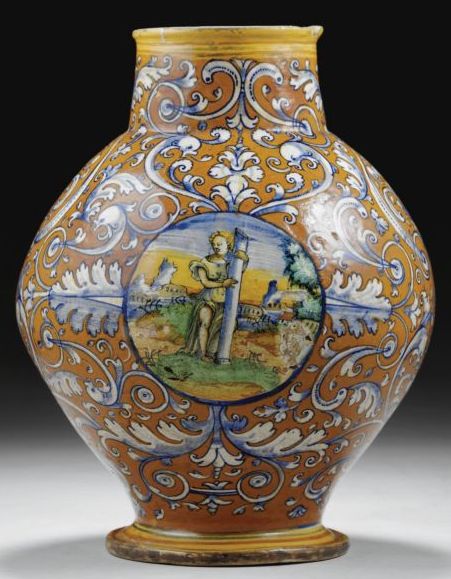
Italian Majolica bulbous vase, circa 1530, Faenza painted with an arrangement of scrolling acanthus on an orange ground
Majolica – A Brief History
Majolica gets its name from its Spanish roots. The pottery was originally made on the island of Majorca and imported to Italy soon after. However, the tin glazes that give majolica its distinctive bright colors were developed by Mesopotamian potters in the 11th century. A little later, artisans in Persia developed a technique for the application of enamel colors on glazed and fired pots that were then refired at lower temperatures to prevent color bleed. This was the precursor of the brilliantly colored tin glazed ware that made its appearance during the Italian Renaissance. Although the technique of painting metallic oxides over a tin glazed surface had been used in the 11th century, the Italians adapted, then refined the technique and referred to the pottery as Maiolica.

French Palissy Ware small oval plaque with fish on sand bar in center, snake, lizard, butterfly, shells and plant life
Design & Technology Come Together in Majolica
In 1558, potter Cipriano Michele di Picolpasso published a treatise on the manufacture methods of majolica, noting that, “Opaque white tin enamel glaze was completely applied to a piece to cover the buff body of the clay, and to provide a good surface for painting.” Paint was then applied to the dry but unfired tin glaze, and the piece was then fired at a high temperature. After that, a second, clear glaze overcoat was applied, and the piece was refired. The earliest majolica took its inspiration from classical Greek, Roman and Egyptian themes, employing motifs such as Sphinx heads, Roman Columns, and goats’ feet. In France, artisan Bernard Palissy created a popular line of Majolica ware in the 16th century that emphasized nature and featured remarkable lifelike renditions of wildlife, particularly marine animals and snakes.
Collecting Majolica
Today, collectors who purchase Majolica are buying Victorian Majolica. According to longtime Majolica dealer Jerry S. Hayes, pre-Victorian pieces almost never come to market, and are found exclusively in museums. Hayes recommends the Majolica collection at the Victoria & Albert in London as well as the collection at the New Orleans Museum of Art.
Early English manufacturers of Majolica included Minton, Wedgwood, George Jones, Joseph Holdcroft, T. Forster, Samuel Lear and S. Fielding. The well-known companies signed their pieces, but the smaller companies, busy producing knock-offs of the industry giants left theirs unidentified, hoping to ride the coat tails of their more successful competitors Much of the majolica collected today is unattributed, but discerning collectors can tell the difference between a major piece and a knock-off by both weight & quality. Mr. Hayes says that collecting majolica has grown in popularity so that most serious collectors have the common pieces and are looking for the rare and unusual. And due to the large number of collectors, what was once considered unusual is becoming easier to find. In terms of value, Hayes recommends avoiding pieces that are damaged, but due to the fragile nature of the ware, believes that restored pieces are fine for most collectors, particularly if the restored piece is one of the hard-to-finds.
-by p4A Contributing Editor Susan Cramer.
Reference & Further Recommended Reading:
To search the Prices4Antiques antiques reference database for valuation information on hundreds of thousands of antiques and fine art visit our homepage www.prices4antiques.com





No comments
Comments feed for this article
Trackback link: https://www.prices4antiques.com/blog/history-of-majolica/trackback/